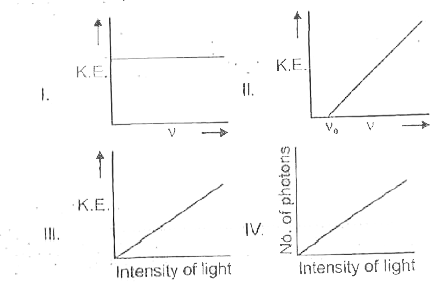Which is / are incorrect observations related to photoelectric effect ?
When intensity of light is increased then kinetic energy of photo electron increases
If frequency of incident light isless than threshold frequency photoelectron is ejected from the metal surface, if we increase the intensity light
Photoelectric current is proportionalto the frequency of incident light
When frequency of light is increased , velocity of photoelectron increased
The correct Answer is:1,2,3
To determine which observations related to the photoelectric effect are incorrect, we can analyze each statement provided in the question.
1. Observation A: "When intensity of light is increased, kinetic energy of photoelectrons increases."
- Analysis: This statement is incorrect. Increasing the intensity of light increases the number of photoelectrons emitted, but it does not increase their kinetic energy. The kinetic energy of photoelectrons is determined by the frequency of the incident light, not its intensity.
2. Observation B: "If frequency of incident light is less than threshold frequency, photoelectrons are ejected from the metal surface."
- Analysis: This statement is also incorrect. If the frequency of the incident light is below the threshold frequency, no photoelectrons will be ejected from the metal surface, regardless of the intensity of the light.
3. Observation C: "Photoelectric current is proportional to the frequency of incident light."
- Analysis: This statement is incorrect as well. The photoelectric current is proportional to the number of photoelectrons emitted, which is related to the intensity of the light, not the frequency. The frequency must be above the threshold for any current to be generated, but once that is achieved, increasing frequency does not increase the current.
4. Observation D: "When frequency of light is increased, velocity of photoelectrons increases."
- Analysis: This statement is correct. As the frequency of the light increases, the energy of the emitted photoelectrons increases, which leads to an increase in their velocity.
Conclusion:
The incorrect observations related to the photoelectric effect are:
- A: When intensity of light is increased, kinetic energy of photoelectrons increases.
- B: If frequency of incident light is less than threshold frequency, photoelectrons are ejected from the metal surface.
- C: Photoelectric current is proportional to the frequency of incident light.
Thus, the answer is A, B, and C.
---
- Analysis: This statement is incorrect. Increasing the intensity of light increases the number of photoelectrons emitted, but it does not increase their kinetic energy. The kinetic energy of photoelectrons is determined by the frequency of the incident light, not its intensity.
2. Observation B: "If frequency of incident light is less than threshold frequency, photoelectrons are ejected from the metal surface."
- Analysis: This statement is also incorrect. If the frequency of the incident light is below the threshold frequency, no photoelectrons will be ejected from the metal surface, regardless of the intensity of the light.
- Analysis: This statement is incorrect as well. The photoelectric current is proportional to the number of photoelectrons emitted, which is related to the intensity of the light, not the frequency. The frequency must be above the threshold for any current to be generated, but once that is achieved, increasing frequency does not increase the current.
- Analysis: This statement is correct. As the frequency of the light increases, the energy of the emitted photoelectrons increases, which leads to an increase in their velocity.
The incorrect observations related to the photoelectric effect are:
- A: When intensity of light is increased, kinetic energy of photoelectrons increases.
- B: If frequency of incident light is less than threshold frequency, photoelectrons are ejected from the metal surface.
- C: Photoelectric current is proportional to the frequency of incident light.
Topper's Solved these Questions
- STRUCTURE OF ATOM BOOK - AAKASH INSTITUTE ENGLISHCHAPTER - STRUCTURE OF ATOM EXERCISE - ASSIGNMENT ( SECTION -D) Linked Comprehension Type Questions)
9 Videos
- STRUCTURE OF ATOM BOOK - AAKASH INSTITUTE ENGLISHCHAPTER - STRUCTURE OF ATOM EXERCISE - ASSIGNMENT ( SECTION -E) Assertion - Reason Type Questions
10 Videos
- STRUCTURE OF ATOM BOOK - AAKASH INSTITUTE ENGLISHCHAPTER - STRUCTURE OF ATOM EXERCISE - ASSIGNMENT ( SECTION -B) Objective Type Questions (One option is correct)
38 Videos
- STRUCTURE OF ATOMBOOK - AAKASH INSTITUTE ENGLISHCHAPTER - STRUCTURE OF ATOMEXERCISE - ASSIGNMENT (SECTION -D) Assertion-Reason Type Questions
15 Videos
- SURFACE CHEMISTRY BOOK - AAKASH INSTITUTE ENGLISHCHAPTER - SURFACE CHEMISTRY EXERCISE - Assignment Section - C (Assertion - Reason type questions)
10 Videos
Similar Questions
Knowledge Check
Mark the incorect statement regarding the photoelectric effect.
AThere is no time lag between the striking of light beam and the ejection of electrons from the metal surface.BThe number of electrons ejected is inversely proportional to the intensity of light.CPhotoelectric effect is not observed below threshold frequency.DThe kinetic energy of the electrons increases with increase in frequency of light used.
Incorrect relation is
View Solutioncan X-rays be used for photoelectric effect?
View SolutionWhich is the graph with respect to photoelectric effect?
View SolutionChoose the correct statements regarding the phenomena of photoelectric effect
View SolutionWhich alkali metal do not show photoelectric effect?
View SolutionWhich relation is incorrect :-
View SolutionWhich alkali mettal do not show photoelectric effect?
View Solution

